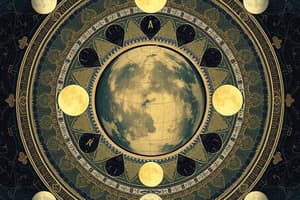Podcast
Questions and Answers
Which factor most directly influences the variation of sunlight received at different latitudes?
Which factor most directly influences the variation of sunlight received at different latitudes?
- The Moon's gravitational influence
- Earth's axial tilt (correct)
- The speed of Earth's rotation
- The distance of different locations to the equator
What causes the seasons on Earth?
What causes the seasons on Earth?
- The distance of Earth from the Sun
- The gravitational pull of the Moon
- The tilt of Earth's axis (correct)
- The shape of Earth's orbit
During which phase of the Moon does a solar eclipse occur?
During which phase of the Moon does a solar eclipse occur?
- New Moon (correct)
- Full Moon
- Waning Crescent
- First Quarter
What happens to the height of the Sun in the sky during summer in the Northern Hemisphere?
What happens to the height of the Sun in the sky during summer in the Northern Hemisphere?
What phenomenon occurs when the Moon passes between the Earth and the Sun?
What phenomenon occurs when the Moon passes between the Earth and the Sun?
What is the main reason for the different lengths of day and night throughout the year?
What is the main reason for the different lengths of day and night throughout the year?
Which phase of the Moon occurs when the Moon is on the opposite side of the Earth from the Sun?
Which phase of the Moon occurs when the Moon is on the opposite side of the Earth from the Sun?
How does the Earth's axial tilt contribute to seasonal changes?
How does the Earth's axial tilt contribute to seasonal changes?
During which season does the Northern Hemisphere experience the longest day?
During which season does the Northern Hemisphere experience the longest day?
What role does the Moon play in influencing tides on Earth?
What role does the Moon play in influencing tides on Earth?
Flashcards are hidden until you start studying
Study Notes
Earth-Sun-Moon System
- The Earth revolves around the Sun in an elliptical orbit, leading to seasonal changes based on axial tilt and solar radiation.
- The Moon orbits Earth approximately every 27.3 days, influencing tides through gravitational pull.
- Solar and lunar eclipses occur due to the alignment of the Earth, Moon, and Sun; solar eclipses happen when the Moon passes between the Earth and the Sun, while lunar eclipses occur when Earth is between the Sun and the Moon.
Seasons
- Seasons are caused by the tilt of the Earth's axis at an angle of 23.5 degrees, affecting sunlight distribution.
- During summer solstice, the Northern Hemisphere tilts towards the Sun, resulting in longer days and warmer temperatures.
- In contrast, the winter solstice causes the Northern Hemisphere to tilt away from the Sun, resulting in shorter days and cooler temperatures.
- Equinoxes, occurring in spring and autumn, mark the points when day and night are approximately equal in length globally.
- The Southern Hemisphere experiences opposite seasons to the Northern Hemisphere due to the Earth's axial tilt and orbit around the Sun.
Earth-Sun-Moon System
- The Earth revolves around the Sun in an elliptical orbit, leading to seasonal changes based on axial tilt and solar radiation.
- The Moon orbits Earth approximately every 27.3 days, influencing tides through gravitational pull.
- Solar and lunar eclipses occur due to the alignment of the Earth, Moon, and Sun; solar eclipses happen when the Moon passes between the Earth and the Sun, while lunar eclipses occur when Earth is between the Sun and the Moon.
Seasons
- Seasons are caused by the tilt of the Earth's axis at an angle of 23.5 degrees, affecting sunlight distribution.
- During summer solstice, the Northern Hemisphere tilts towards the Sun, resulting in longer days and warmer temperatures.
- In contrast, the winter solstice causes the Northern Hemisphere to tilt away from the Sun, resulting in shorter days and cooler temperatures.
- Equinoxes, occurring in spring and autumn, mark the points when day and night are approximately equal in length globally.
- The Southern Hemisphere experiences opposite seasons to the Northern Hemisphere due to the Earth's axial tilt and orbit around the Sun.
Studying That Suits You
Use AI to generate personalized quizzes and flashcards to suit your learning preferences.




